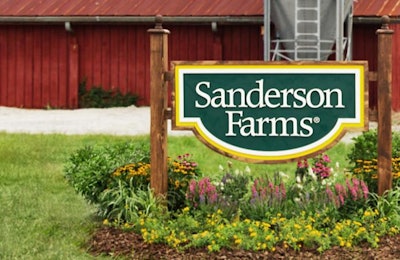
Ordinary problems with hatchability and livability can be further complicated when the breeding stock and pullets are raised as part of no antibiotics ever (NAE) programs, the CEO of Sanderson Farms said.
While participating in the Goldman Sachs Global Staples Forum on May 18, Joe F. Sanderson Jr. addressed the recent attention given to Tyson Foods and the company’s decision to change its male breeding stock in an effort to improve productivity in its breeder operations and ultimately increase the number of broilers processed.
During a quarterly earnings call and following conference call with journalists last week, Tyson Foods Chief Operating Officer Donnie King said the male breeder line the company had been using did produce offspring with desired broiler characteristics such as higher yields and better performance in growout, but those birds fell short concerning breeding characteristics such as egg production and hatchability.
While Sanderson did not mention Tyson Foods by name, he said the problems that were described on the call aren’t that uncommon for those breeds.
“People started using these breeds several years ago to produce more breast meat, and (these breeds) are very difficult to grow,” Sanderson said.
He described working with those breeds as “walking on a knife’s edge to get them to produce a fertile egg and not get overweight.”
Those challenges can be exacerbated in NAE programs, said Sanderson, who has long been critical of the animal health and welfare challenges of NAE production.
Sanderson Farms’ standard husbandry programs allow for judicious use of non-medically important antibiotics.
Sanderson said his company treats its pullets with antibiotics, which he says not only helps them in the early stages of live, but through the entire grow-out process.
“When you look at hatchability, more breeders doesn’t mean more chickens, necessarily,” he said. “We have all of our pullets treated with antibiotics. We think they’re healthier and they go through the pullet growing and the henhouse better. But when you don’t treat the pullet … the pullet grows into a hen, and she just doesn’t perform as well. She’s subject to E. Coli and more disease, and so she doesn’t produce.”
Also during the Goldman Sachs Global Staples Forum, Sanderson discussed the present chicken wing shortage and the need to adjust prices accordingly at the retail level.

















